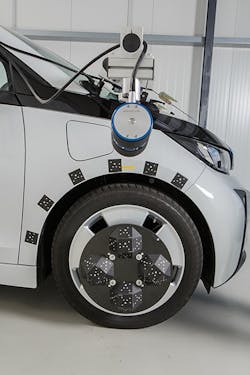By incorporating high-speed EoSens GE GigE Vision cameras from Mikrotron into its WheelWatch optical measurement system, AICON 3D System GmbH has set a new standard for non-contact monitoring of wheel motion in vehicle dynamics testing.
With a maximum speed of almost 500 frames per second, Mikrotron EoSens GE cameras feature a 1.3 megapixel CMOS sensor that captures a resolution of 1280 x 1024 pixels with a 90 dB dynamic range. As a result, the WheelWatch system is able to capture sharp, high-contrast images for critical analysis, even at driving speeds of up to 155 mph, including the accurate measurement of wheel parameters such as track, camber inclination, spring travel, clearance, and steering angle.
The WheelWatch is used at the prototype stage in automobile development. Before a car gets anywhere close to serial production, prototypes have already covered millions of miles during testing. As part of this process, careful testing examines exactly how wheels behave in the event of extreme maneuvers. How do they handle bumps and wet roads? Do they remain stable during evasive maneuvers or when traveling at high speed? Do the wheel wells still provide enough room even when tackling sharp bends? These are the types of dynamic parameters that the WheelWatch captures for analysis.
During testing, Mikrotron EoSens GE cameras are exposed to extreme forces like sudden accelerations, sharp steering maneuvers, and abrupt braking that would damage a standard camera. Equally challenging, the camera is expected to function during lengthy driving tests lasting several hours. Mikrotron EoSens cameras --featuring a fanless, shock- and vibration-proof design within a robust metal housing --proved up to the task, achieving long-term stability over hundreds of tests.
"We found the Mikrotron EoSens camera operates reliably, despite sometimes facing tough operating conditions," confirms Robert Godding, Managing Director of AICON 3D Systems GmbH. "The camera always provided high-quality image data."
Simple Installation
System set-up requires one Mikrotron EoSens GE camera to be attached per wheel to enable it to fully capture the wheel and mudguard. Specially coded measurement targets are placed on the mudguard to identify the vehicle coordinate system. An adapter is also mounted on the wheel, featuring a unique pattern of dots.
Once installed, the Mikrotron EoSens GE camera acquires images of the wheel while simultaneously aligning itself with the surrounding mudguard, so it does not have to be kept stable. Vibrations and bumps do not have any effect on the data measured. The system recalculates its position continuously to achieve the measuring data, thereby achieving maximum positional accuracy of approx. ± 0.1 mm and angular accuracy of approx. ± 0.015-deg. Consequently, driving characteristics of the vehicle are not influenced by the measurement equipment, nor is steering motion restricted in any way.
The Mikrotron EoSens GE triggering function allows multiple cameras to be fully synchronized for simultaneous monitoring of several wheels or axles. Special optical targets applied to the prototype's fender define the vehicle coordinate system, while a lightweight carbon fiber wheel adapter is fixed to the wheel. The driver manually triggers the beginning and end of a measurement session. No other interaction with WheelWatch is required.
Up to four cameras can be synchronized with each other, as well as with other measuring sensors. For example, movements in the engine block can also be detected using additional cameras. Getting into tight spots within the engine block is made possible by the Mikrotron camera housing measuring only 63 x 63 x 47 mm.
Evaluating Images in the Camera
WheelWatch measurement images are assessed in the Mikrotron camera sensor using an FPGA image analysis processor before they are sent to a laptop inside the car via a GigE interface. Wheel target positions and target trajectories are available shortly after the image acquisition. In addition, WheelWatch computes all six degrees of freedom of the wheel in the vehicle coordinate system.
Mr. Godding considers the integrated FPGA technology to be a key camera performance feature: "Being able to use the built-in FPGA for our own image processing purposes was one of the reasons we opted for a Mikrotron camera."
The WheelWatch system can be deployed both on a test station as well as during drives on a test track. However, it is also ideal for other movement analyses such as:
- Door slam testing
- Examining the opening and closing behavior of doors, covers, windows
- Vibration analysis of components
- Robot rail measurement
- Machine control
- Error analysis in the production line (e.g. welding processes)
- Component behavior in wind tunnels or climatic chambers
- Collision analyses
- Material testing, structural analysis
- 6D positioning and alignment of individual points and rigid bodies.













